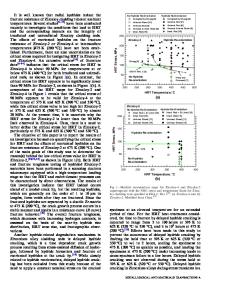Relationships of slip morphology, microcracking, and fracture resistance in a lamellar TiAl-alloy
- PDF / 4,159,927 Bytes
- 12 Pages / 598.28 x 778.28 pts Page_size
- 38 Downloads / 290 Views
I.
INTRODUCTION
RECENT advances in thermomechanical processing and heat treatment have led to the development of a variety of microstructures for TiAl-based alloys, tL2,3j The microstructures of two-phase TiAl-alloys are generally characterized in terms of the relative volume fractions of equiaxed 3' grains and lamellar colonies present. The equiaxed 3' grain microstructure consists of mostly 3' grains, while the lamellar microstructure contains colonies of aligned a2 + 3' platelets. Microstructures with various mixtures of equiaxed 3' grains and lamellar colonies are possible. A microstructure comprised of comparable volume fractions of equiaxed 3' grains and lamellar colonies is referred to as the duplex microstructure. Like traditional Ti-alloys, the mechanical properties of TiAl-based alloys depend significantly on the microstructure. In general, the lamellar microstructure is more fracture resistant than the equiaxed 3"grain or the duplex microstructure. [3-~~ Recent work has revealed that fracture resistance in lamellar TiAl-alloys is the consequence of the formation of noncoplanar microcracks ahead of the crack tip, resulting in intact ligaments between the main crack and the microcracks. [s'6'9-13) These ligaments act to hinder crack-surface opening and must be deformed and fractured before further extension of the main crack can proceed. Redundant deformation and fracture in the ligaments leads to an enhancement in the crack-growth toughness that is manifested as a resistance-curve effect. While many aspects of the ligament-toughening process have been established, important issues about this extrinsic-toughening mechanism remain unanswered. K.S. CHAN, Staff Scientist, is with Southwest Research Institute, San Antonio, TX 78238-5166. Y-W. KIM, Chief Scientist, is with Universal Energy Systems, Materials Research Division, Dayton, OH 45432-1894. Manuscript submitted September 20, 1993. METALLURGICAL AND MATERIALS TRANSACTIONS A
For example, what are the underlying micromechanical and microstructural factors affecting (1) the formation of microcracks, (2) the deformation characteristics and the source of toughness in the crack-wake ligaments, and (3) the role of deformation rate in the fracture and toughening processes? A previous micromechanical model tHJ has shown that for obvious reasons, ligament toughening is most effective when ligaments with high toughness are present in the microstructure. The deformation characteristics of the ligaments that are responsible for ligament toughening in lamellar TiAl-alloys have not been studied. Thus, the source of toughness in the ligaments remains unresolved. A complete understanding of the microstructure/fracture relationship in lamellar TiAIalloys cannot be established until these outstanding issues are resolved. Despite some similarities that have been reported for fatigue crack growth, t~41there are important differences between TiAl-alloys and conventional Ti-alloys when fracture toughness and tensile ductility are considered. A particular example is that ex
Data Loading...











